|
|
|
Sort Order |
|
|
|
Items / Page
|
|
|
|
|
|
|
| Srl | Item |
| 1 |
ID:
113390


|
|
|
| 2 |
ID:
045807


|
|
|
|
|
| Publication |
BlanndFord, Davison Publishing Limited, 1976.
|
| Description |
x, 170p.hbk
|
| Standard Number |
0904130088
|
|
|
|
|
|
|
|
|
|
|
|
Copies: C:1/I:0,R:0,Q:0
Circulation
| Accession# | Call# | Current Location | Status | Policy | Location |
| 016226 | 960.32/TIM 016226 | Main | On Shelf | General | |
|
|
|
|
| 3 |
ID:
184863
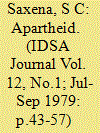

|
|
|
| 4 |
ID:
132460
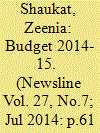

|
|
|
|
|
| Publication |
2014.
|
| Summary/Abstract |
This year's budget presented by the PML-N has been centred around economic growth.The question is whether this growth will be achieved at the expense of the masses.
|
|
|
|
|
|
|
|
|
|
|
|
|
|
|
|
| 5 |
ID:
168193
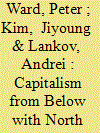

|
|
|
|
|
| Summary/Abstract |
Post-socialist transformation has been studied extensively in Eastern Europe, the former Soviet Union, and other states in Asia. This article will examine the North Korean experience and suggests how North Korea's post-socialist experience can be positioned within the broader picture of post-socialism. In this article we focus on the following three areas: the state sector, capitalist class formation and capital accumulation, and the role of foreign investment. We rely on a reading of North Korean laws and North Korean official publications, previous survey work involving firms dealing with North Korea in the past and present, as well as official North Korean census data to offer as full a picture as is possible.
|
|
|
|
|
|
|
|
|
|
|
|
|
|
|
|
| 6 |
ID:
189866
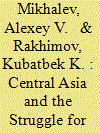

|
|
|
|
|
| Summary/Abstract |
The paper discusses the “struggle for Soviet legacy’ as a key concept for
understanding relations in Central Asia. This struggle is a path of dependent
development, in which the resources and values created in Soviet times
determine interstate relations in the 21st century. The authors argue that in
Central Asia this legacy rests mostly on the mega industries created during
the Soviet era, and national resources and practices of their distribution.
The paper concludes that in fact the struggle for Soviet legacy means
confrontation over the contours of new geoeconomics in Asia.
|
|
|
|
|
|
|
|
|
|
|
|
|
|
|
|
| 7 |
ID:
164072
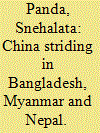

|
|
|
|
|
| Summary/Abstract |
China has pulled into its orbit relatively poor South Asian countries like Bangladesh, Myanmar and Nepal by extensive economic support and investments in infrastructure development. Bangladesh and Myanmar are important for accessing strategically located ports which will provide it alternative sea routes for unimpeded trade and commerce. Nepal is important to tighten its border with Tibet. Moreover, it is a cleverly planned strategy to access their market, supply military equipment and eclipse India’s influence in these countries. But it is no cakewalk as big international powers are countering China through diplomatic and economic means to constrict its growing influence in South Asia. The local communities are averse to its aid and investment as they apprehend that the projects are intended to benefit the investor and endanger their livelihood as well as environment while governments in each of these countries are striving to balance their relationship with big powers.
|
|
|
|
|
|
|
|
|
|
|
|
|
|
|
|
| 8 |
ID:
128901
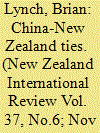

|
|
|
| 9 |
ID:
113719
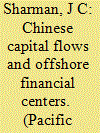

|
|
|
|
|
| Publication |
2012.
|
| Summary/Abstract |
Why is the British Virgin Islands a bigger source of foreign direct investment into China than the USA, the European Union and Japan combined? Why is there 10 times more investment from China in the Caymans Islands than there is in the USA? This paper argues that these flows represent the efforts of Chinese and foreign investors to reduce governance and measurement transaction costs. Investors avail themselves of efficient institutions in offshore centers that are absent locally. These institutional attractions include the ease of raising capital on foreign stock markets, access to reliable courts, and more flexible and sophisticated financial products. Existing explanations of these capital movements, characterizing them as criminal money or tax arbitrage, are insufficient. Evidence is drawn from government statistics, private legal advice and interviews in offshore financial centers.
|
|
|
|
|
|
|
|
|
|
|
|
|
|
|
|
| 10 |
ID:
073044
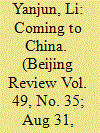

|
|
|
| 11 |
ID:
073330
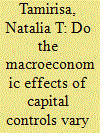

|
|
|
|
|
| Publication |
2006.
|
| Summary/Abstract |
This paper examines how the macroeconomic effects of capital controls vary by type, depending on which international financial transactions they cover. Analysis draws on the experience of Malaysia, a country that used a gamut of permanent and temporary capital controls over the past decade. In an error-correction model, we find that controls on portfolio inflows, and restrictions on bank, foreign exchange, and stock market operations helped drive a wedge between domestic and international interest rates. This finding is robust to alternative specifications of the model and alternative measures of capital controls. Controls on portfolio outflows and international transactions in the Malaysian ringgit do not appear to have been instrumental in providing more monetary independence to the authorities.
|
|
|
|
|
|
|
|
|
|
|
|
|
|
|
|
| 12 |
ID:
117531
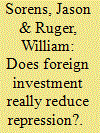

|
|
|
|
|
| Publication |
2012.
|
| Summary/Abstract |
Cross-national empirical studies have found that foreign investment has beneficial effects on human rights. We argue that these studies poorly operationalize foreign investment to test theoretical predictions and suffer from sampling bias. We demonstrate that investment stock, rather than inflow, is the superior operationalization of structural dependence theory. We construct regression models of government repression of physical integrity rights, include much more data than previous studies, and use a new multiple imputation algorithm for time-series cross-section data to resolve sampling bias. We find no evidence that foreign investment affects repression, contradicting conventional wisdom and suggesting that the political gains from repression frequently dwarf any economic costs for governments.
|
|
|
|
|
|
|
|
|
|
|
|
|
|
|
|
| 13 |
ID:
124517
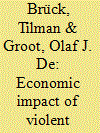

|
|
|
|
|
| Publication |
2013.
|
| Summary/Abstract |
Much of the work published in Defence and Peace Economics (DPE) significantly contributes to our understanding of the economics of conflict. Analyzing the second decade of its existence, Arce and Kollias (2010) showed that over time, the emphasis of work in DPE has shifted significantly. One rising field examines the consequences of conflict. Related to this, in 2011, DIW Berlin hosted a conference examining The Economic Impact of Violent Conflict. This special issue is the result of that conference. While this may seem like a relatively narrow area, the interpretation of that simple combination of words can be quite broad. Some of the core work in the area focuses on the calculation of the global impact of conflict (Collier, 1999, Hess, 2003, Brück, De Groot, and Bozzoli, 2012). The work of Collier (1999) has had the greatest impact and continues to do so. He focuses only on civil conflicts because of the perceived economic strengthening effects of international conflict. Collier argues that civil conflict affects growth through (i) the destruction of resources; (ii) the disruption of infrastructure and social order; (iii)
budgetary substitution; (iv) dissaving; and (v) portfolio substitution by foreign investors.
The first four of these channels are expected to influence an economy only during conflict, whereas the final one is likely to continue having a lasting effect even after the restoration of peace. This led Collier to come to his theory that the length of the conflict is going to influence the impact of the post conflict period. In particular, he argues that long-running conflicts are more likely to be followed by an increase in growth, whereas short-lasting conflicts will suffer reduced growth rates over a longer period of time (known as a legacy effect).
|
|
|
|
|
|
|
|
|
|
|
|
|
|
|
|
| 14 |
ID:
086756
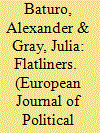

|
|
|
|
|
| Publication |
2009.
|
| Summary/Abstract |
What factors explain the wave of adoption of the flat tax in Eastern Europe? It is argued in this article that, once the first few successes were underway, governments with liberal outlooks toward taxation adopted the reform through a process of rational learning: an often radically new government will tend to adopt the policy based on successful implementation of its neighbours. The issue of policy diffusion is approached by explicitly modeling the different mechanisms that might underlie the process. Little evidence is found for pure 'bandwagoning' in the adoption of the flat tax - the presence of other market-minded reforms do not predict adoption of the flat tax, and contagion measures do not capture the dynamics of the adoption of the reform. Instead, rational learning, where economically right-wing governments evaluated the success of the reform (as measured by their ability to attract foreign investment) in the medium term, plays the largest role. Rational emulation in a shorter time period contributes to the probability of adoption as well, as does a change to an economically liberal ideology.
|
|
|
|
|
|
|
|
|
|
|
|
|
|
|
|
| 15 |
ID:
098052
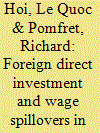

|
|
|
| 16 |
ID:
161581


|
|
|
|
|
| Summary/Abstract |
This paper provides a survey of foreign investment activity in China's high‐technology manufacturing industry. In addition, we closely examine the relationship between industrial policy, foreign investment and China's high‐technology export success using the development of an indigenous integrated circuits industry as a case study. This paper finds that China's efforts to raise the productivity and innovative capacity of indigenous enterprises is consistent with rising domestic shares of high‐technology assets and profits. Nevertheless, foreign‐funded enterprises remain the source of most high‐technology manufactured exports, primarily from wholly foreign‐owned firms. In sum, despite indigenous development, Chinese high‐technology manufacturing and exports remain deeply tied to foreign investment.
|
|
|
|
|
|
|
|
|
|
|
|
|
|
|
|
| 17 |
ID:
091325


|
|
|
|
|
| Publication |
2009.
|
| Summary/Abstract |
It is not happening in Pakistan alone. Prime farmland in other developing countries is also being acquired by foreign investors, mainly from the West and the oil-rich Middle Eastern countries.
|
|
|
|
|
|
|
|
|
|
|
|
|
|
|
|
| 18 |
ID:
081897
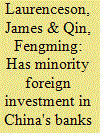

|
|
|
|
|
| Publication |
2008.
|
| Summary/Abstract |
Since 2001, foreign investors have been permitted to acquire minority ownership stakes in China's banks. This paper assesses whether there is any evidence of a cost efficiency payoff in those banks that have taken on foreign investment. Data envelopment analysis is first used to generate measures of cost efficiency for China's banks over the period 2001-2006. A second stage regression is then performed to determine whether foreign investment has an impact on cost efficiency. The results indicate a positive relationship, although one that is not statistically significant. Policy implications are discussed
|
|
|
|
|
|
|
|
|
|
|
|
|
|
|
|
| 19 |
ID:
086010
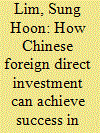

|
|
|
|
|
| Publication |
2008.
|
| Summary/Abstract |
China is transforming itself into an aggressive investor based upon its more US$1.5 tillion in foreign exchange reserves, the world's largest. However, despite the huge expansion in quality base, the substantial performace of Chinese investors, in terms of gains in profit and technology spillover effects through overseas investment, has not been satisfactory.
|
|
|
|
|
|
|
|
|
|
|
|
|
|
|
|
| 20 |
ID:
185358
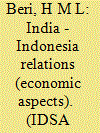

|
|
|
|
|
|
|
|